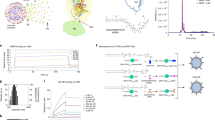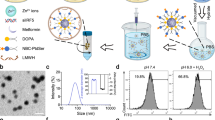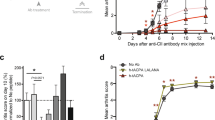Abstract
Rheumatoid arthritis is a common chronic inflammatory disorder and a major cause of disability. Despite the progress made with recent clinical use of anti-cytokine biologics, the response rate of rheumatoid arthritis treatment remains unsatisfactory, owing largely to the complexity of cytokine interactions and the multiplicity of cytokine targets. Here, we show a nanoparticle-based broad-spectrum anti-inflammatory strategy for rheumatoid arthritis management. By fusing neutrophil membrane onto polymeric cores, we prepare neutrophil membrane-coated nanoparticles that inherit the antigenic exterior and associated membrane functions of the source cells, which makes them ideal decoys of neutrophil-targeted biological molecules. It is shown that these nanoparticles can neutralize proinflammatory cytokines, suppress synovial inflammation, target deep into the cartilage matrix, and provide strong chondroprotection against joint damage. In a mouse model of collagen-induced arthritis and a human transgenic mouse model of arthritis, the neutrophil membrane-coated nanoparticles show significant therapeutic efficacy by ameliorating joint damage and suppressing overall arthritis severity.
This is a preview of subscription content, access via your institution
Access options
Access Nature and 54 other Nature Portfolio journals
Get Nature+, our best-value online-access subscription
$29.99 / 30 days
cancel any time
Subscribe to this journal
Receive 12 print issues and online access
$259.00 per year
only $21.58 per issue
Buy this article
- Purchase on Springer Link
- Instant access to full article PDF
Prices may be subject to local taxes which are calculated during checkout





Similar content being viewed by others
Data availability
The data that support the plots within this paper and other findings of this study are available from the corresponding author upon reasonable request.
References
Smolen, J. S. & Aletaha, D. Rheumatoid arthritis therapy reappraisal: strategies, opportunities and challenges. Nat. Rev. Rheumatol. 11, 276–289 (2015).
Firestein, G. S. Evolving concepts of rheumatoid arthritis. Nature 423, 356–361 (2003).
Firestein, G. S. & McInnes, I. B. Immunopathogenesis of rheumatoid arthritis. Immunity 46, 183–196 (2017).
Burmester, G. R., Feist, E. & Doerner, T. Emerging cell and cytokine targets in rheumatoid arthritis. Nat. Rev. Rheumatol. 10, 77–88 (2014).
Goulielmos, G. N. et al. Genetic data: the new challenge of personalized medicine, insights for rheumatoid arthritis patients. Gene 583, 90–101 (2016).
McInnes, I. B. & Schett, G. Cytokines in the pathogenesis of rheumatoid arthritis. Nat. Rev. Immunol. 7, 429–442 (2007).
Noack, M. & Miossec, P. Selected cytokine pathways in rheumatoid arthritis. Semin. Immunopathol. 39, 365–383 (2017).
Choy, E. H. S. & Panayi, G. S. Mechanisms of disease: cytokine pathways and joint inflammation in rheumatoid arthritis. New Engl. J. Med. 344, 907–916 (2001).
Smolen, J. S. et al. New therapies for treatment of rheumatoid arthritis. Lancet 370, 1861–1874 (2007).
Bykerk, V. Unmet needs in rheumatoid arthritis. J. Rheumatol. 36, 42–46 (2009).
Taylor, P. C. et al. A structured literature review of the burden of illness and unmet needs in patients with rheumatoid arthritis: a current perspective. Rheumatol. Int. 36, 685–695 (2016).
Iwata, S. & Tanaka, Y. Progress in understanding the safety and efficacy of janus kinase inhibitors for treatment of rheumatoid arthritis. Exp. Rev. Clin. Immunol. 12, 1047–1057 (2016).
Smolen, J. S. et al. Treating rheumatoid arthritis to target: 2014 update of the recommendations of an international task force. Ann. Rheum. Dis. 75, 3–15 (2016).
Hu, C. M. J. et al. A biomimetic nanosponge that absorbs pore-forming toxins. Nat. Nanotech. 8, 336–340 (2013).
Hu, C. M. J. et al. Nanoparticle biointerfacing by platelet membrane cloaking. Nature 526, 118–121 (2015).
Copp, J. A. et al. Clearance of pathological antibodies using biomimetic nanoparticles. Proc. Natl Acad. Sci. USA 111, 13481–13486 (2014).
Thamphiwatana, S. et al. Macrophage-like nanoparticles concurrently absorbing endotoxins and proinflammatory cytokines for sepsis management. Proc. Natl Acad. Sci. USA 114, 11488–11493 (2017).
Tak, P. P. et al. Analysis of the synovial cell infiltrate in early rheumatoid synovial tissue in relation to local disease activity. Arthritis Rheum. 40, 217–225 (1997).
Horckmans, M. et al. Neutrophils orchestrate post-myocardial infarction healing by polarizing macrophages towards a reparative phenotype. Eur. Heart J. 38, 187–197 (2017).
Dalli, J. et al. Heterogeneity in neutrophil microparticles reveals distinct proteome and functional properties. Mol. Cell. Proteomics 12, 2205–2219 (2013).
Headland, S. E. Neutrophil-derived microvesicles enter cartilage and protect the joint in inflammatory arthritis. Sci. Transl. Med. 7, 315ra190 (2015).
Wright, H. L., Moots, R. J. & Edwards, S. W. The multifactorial role of neutrophils in rheumatoid arthritis. Nat. Rev. Rheumatol. 10, 593–601 (2014).
Wipke, B. T. & Allen, P. M. Essential role of neutrophils in the initiation and progression of a murine model of rheumatoid arthritis. J. Immunol. 167, 1601–1608 (2001).
Cedergren, J., Forslund, T., Sundqvist, T. & Skogh, T. Intracellular oxidative activation in synovial fluid neutrophils from patients with rheumatoid arthritis but not from other arthritis patients. J. Rheumatol. 34, 2162–2170 (2007).
Chakravarti, A., Raquil, M. A., Tessier, P. & Poubelle, P. E. Surface RANKL of Toll-like receptor 4-stimulated human neutrophils activates osteoclastic bone resorption. Blood 114, 1633–1644 (2009).
Wright, H. L., Cox, T., Moots, R. J. & Edwards, S. W. Neutrophil biomarkers predict response to therapy with tumor necrosis factor inhibitors in rheumatoid arthritis. J. Leukocyte Biol. 101, 785–795 (2017).
Hu, C.-M. J. et al. Erythrocyte membrane-camouflaged polymeric nanoparticles as a biomimetic delivery platform. Proc. Natl Acad. Sci. USA 108, 10980–10985 (2011).
Declerck, L. S. et al. Expression of neutrophil activation markers and neutrophil adhesion to chondrocytes in rheumatoid-arthritis patients—relationship with disease-activity. Res. Immunol. 146, 81–87 (1995).
Karsten, E., Breen, E. & Herbert, B. R. Red blood cells are dynamic reservoirs of cytokines. Sci. Rep. 8, 3101 (2018).
Brzustewicz, E. et al. Heterogeneity of the cytokinome in undifferentiated arthritis progressing to rheumatoid arthritis and its change in the course of therapy. Move toward personalized medicine. Cytokine 97, 1–13 (2017).
Ley, K., Laudanna, C., Cybulsky, M. I. & Nourshargh, S. Getting to the site of inflammation: the leukocyte adhesion cascade updated. Nat. Rev. Immunol. 7, 678–689 (2007).
Schmidt, E. P. et al. The pulmonary endothelial glycocalyx regulates neutrophil adhesion and lung injury during experimental sepsis. Nat. Med. 18, 1217–1223 (2012).
Brand, D. D., Latham, K. A. & Rosloniec, E. F. Collagen-induced arthritis. Nat. Protoc. 2, 1269–1275 (2007).
Williams, R. O., Marinova-Mutafchieva, L., Feldmann, M. & Maini, R. N. Evaluation of TNF-α and IL-1 blockade in collagen-induced arthritis and comparison with combined anti-TNF-α/anti-CD4 therapy. J. Immunol. 165, 7240–7245 (2000).
Joosten, L. A. B. et al. Il-1αβ blockade prevents cartilage and bone destruction in murine type II collagen-induced arthritis, whereas TNF-α blockade only ameliorates joint inflammation. J. Immunol. 163, 5049–5055 (1999).
Maia, M. et al. CD248 and its cytoplasmic domain a therapeutic target for arthritis. Arthritis Rheum. 62, 3595–3606 (2010).
Pascual, V. et al. Role of interleukin-1 (IL-1) in the pathogenesis of systemic onset juvenile idiopathic arthritis and clinical response to IL-1 blockade. J. Exp. Med. 201, 1479–1486 (2005).
Bartok, B. & Firestein, G. S. Fibroblast-like synoviocytes: key effector cells in rheumatoid arthritis. Immunol. Rev. 233, 233–255 (2010).
Li, P. & Schwarz, E. M. The TNF-α transgenic mouse model of inflammatory arthritis. Springer Semin. Immunopathol. 25, 19–33 (2003).
Shealy, D. J. et al. Anti-TNF-α antibody allows healing of joint damage in polyarthritic transgenic mice. Arthritis Res. 4, R7 (2002).
Seeuws, S. et al. A multiparameter approach to monitor disease activity in collagen-induced arthritis. Arthritis Res. Ther. 12, R160 (2010).
Kremer, J. M. et al. Treatment of rheumatoid arthritis by selective inhibition of T-cell activation with fusion protein ctla4ig. New Engl. J. Med. 349, 1907–1915 (2003).
Kang, T. et al. Nanoparticles coated with neutrophil membranes can effectively treat cancer metastasis. ACS Nano 11, 1397–1411 (2017).
Dolati, S. et al. Utilization of nanoparticle technology in rheumatoid arthritis treatment. Biomed. Pharmacother. 80, 30–41 (2016).
Tabas, I. & Glass, C. K. Anti-inflammatory therapy in chronic disease: challenges and opportunities. Science 339, 166–172 (2013).
Jie, Z. et al. Large-scale ex vivo generation of human neutrophils from cord blood CD34+ cells. PLoS ONE 12, e0180832 (2017).
Feng, Q. et al. Scalable generation of universal platelets from human induced pluripotent stem cells. Stem Cell Rep. 3, 817–831 (2014).
Graham, J. M. Isolation of human polymorphonuclear leukocytes (granulocytes) from a leukocyte-rich fraction. Sci. World J. 2, 1393–1396 (2002).
Fang, R. et al. Cancer cell membrane-coated nanoparticles for anticancer vaccination and drug delivery. Nano. Lett. 14, 2181–2188 (2014).
Luk, B. T. et al. Interfacial interactions between natural RBC membranes and synthetic polymeric nanoparticles. Nanoscale 6, 2730–2737 (2014).
Acknowledgements
This work is supported by the Defense Threat Reduction Agency Joint Science and Technology Office for Chemical and Biological Defense under grant no. HDTRA1-14-1-0064 and National Science Foundation grant no. DMR-1505699.
Author information
Authors and Affiliations
Contributions
Lia.Z. conceived and designed the experiments with W.G. and Q.Z. Q.Z., X.C., D.D., Y.Z., J.Z. and Lia.Z. performed all experiments. All authors analysed and discussed the data. Q.Z., W.G., R.H.F. and Lia.Z. wrote the paper.
Corresponding author
Ethics declarations
Competing interests
The authors declare no competing interests.
Additional information
Publisher’s note: Springer Nature remains neutral with regard to jurisdictional claims in published maps and institutional affiliations.
Supplementary information
Supplementary Information
Supplementary Figures 1–21, Supplementary Tables 1–3
Rights and permissions
About this article
Cite this article
Zhang, Q., Dehaini, D., Zhang, Y. et al. Neutrophil membrane-coated nanoparticles inhibit synovial inflammation and alleviate joint damage in inflammatory arthritis. Nature Nanotech 13, 1182–1190 (2018). https://doi.org/10.1038/s41565-018-0254-4
Received:
Accepted:
Published:
Issue Date:
DOI: https://doi.org/10.1038/s41565-018-0254-4
This article is cited by
-
HepG2 exosomes coated luteolin nanoparticles remodeling hepatic stellate cells and combination with sorafenib for the treatment of hepatocellular carcinoma
Cancer Nanotechnology (2024)
-
Multimodal nanoimmunotherapy engages neutrophils to eliminate Staphylococcus aureus infections
Nature Nanotechnology (2024)
-
Cell unit-inspired natural nano-based biomaterials as versatile building blocks for bone/cartilage regeneration
Journal of Nanobiotechnology (2023)
-
Functional targeted therapy for glioma based on platelet membrane-coated nanogels
Cancer Nanotechnology (2023)
-
Highly specific neutrophil-mediated delivery of albumin nanoparticles to ectopic lesion for endometriosis therapy
Journal of Nanobiotechnology (2023)



